The small animal running wheel system market is estimated at USD 161.5 million in 2025 and projected to reach USD 265.6 million by 2035, advancing at a CAGR of 5.1%. A market share erosion or gain analysis reveals how different participants may shift positions over the forecast horizon. From 2020 to 2025, revenue climbs from USD 126.0 million to USD 161.5 million, with established suppliers dominating due to trusted quality, standardized designs, and strong relationships with laboratories and research institutes. During this stage, market share remains concentrated among recognized players, minimizing erosion risk for incumbents.
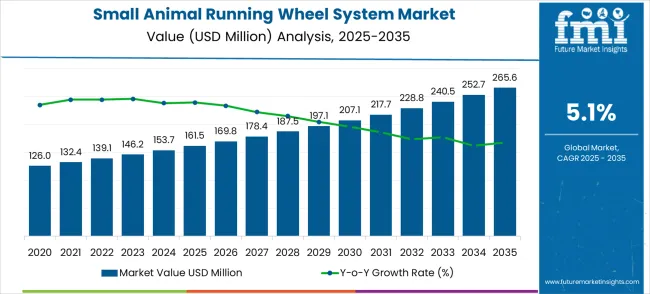
| Metric | Value |
|---|---|
| Market Value (2025) | USD 161.5 million |
| Market Forecast Value (2035) | USD 265.6 million |
| Forecast CAGR (2025-2035) | 5.1% |
Between 2025 and 2030, the market expands from USD 161.5 million to USD 207.1 million, adding USD 45.6 million in value. This mid-period represents a competitive redistribution of shares, as regional manufacturers and niche suppliers introduce cost-effective alternatives and customizable wheel systems for small animals. Market share gains are expected for these newer entrants, especially in academic and small-scale research facilities with limited budgets. Traditional players could experience erosion if they fail to innovate or differentiate beyond basic product reliability. Service offerings such as ergonomic designs, noise reduction, and enhanced data monitoring features will become key levers for capturing incremental share.
From 2030 to 2035, the market grows from USD 207.1 million to USD 265.6 million, representing an absolute gain of USD 58.5 million. In this later stage, share erosion becomes a greater risk for suppliers relying solely on conventional designs, as demand increasingly favors advanced systems with integrated tracking and analytics capabilities. Market share gains will likely shift toward companies offering IoT-enabled running wheel systems for research applications, as well as suppliers targeting broader end-users including veterinary clinics and pet care providers. By 2035, the competitive landscape is expected to be more diversified, with innovative players expanding their presence and established firms experiencing share dilution if they do not adapt to evolving demand preferences.
Market expansion is being supported by revolutionary advances in laboratory animal research technology and pharmaceutical research automation, creating unprecedented opportunities for research standardization and behavioral analysis optimization. Modern research institutions increasingly demand sophisticated animal monitoring systems that enable precise behavioral measurement, standardized research protocols, and reliable data collection for pharmaceutical and toxicology studies. The integration of advanced sensor technology with comprehensive data analytics enables previously impossible levels of research precision and behavioral monitoring standardization.
The growing focus on pharmaceutical research and drug development is driving massive demand for small animal running wheel systems from leading research institutions with proven track records of innovation and research excellence. Research organizations are investing significantly in automated animal research technologies that offer superior data quality while providing enhanced research reproducibility and standardized behavioral assessment through comprehensive monitoring protocols. Research standards are establishing performance benchmarks that favor automated animal research systems with advanced data collection capabilities and superior research standardization features.
The pharmaceutical industry's transformation toward automated research methodologies is creating substantial demand for intelligent animal research products capable of delivering professional-grade behavioral analysis and research standardization through advanced monitoring platforms. The research sector continues to drive innovation in laboratory automation applications while maintaining animal welfare and research ethics standards, leading to development of breakthrough animal research systems with enhanced data accuracy and comprehensive behavioral monitoring capabilities.
The market is segmented by system type, application, and region. By system type, the market is divided into active type (animal spontaneous drive), passive type (motor drive), and other configurations. Based on application, the market is categorized into drug development, rehabilitation research, toxicology, and other applications. Regionally, the market is divided into North America, Europe, East Asia, South Asia & Pacific, Latin America, and Middle East & Africa.
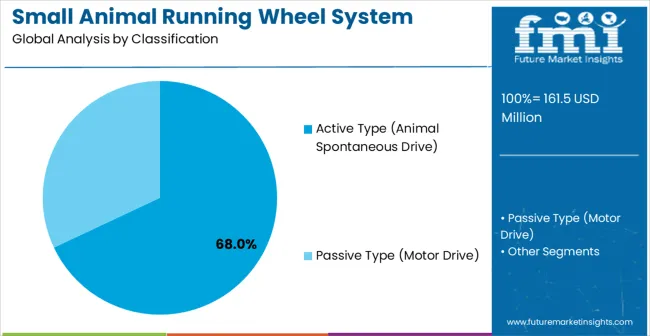
Active type (animal spontaneous drive) configurations are projected to account for 68% of the small animal running wheel system market in 2025. This leading share is supported by explosive adoption of naturalistic behavioral research methodologies and growing demand for voluntary activity monitoring in pharmaceutical research applications. Active type running wheel systems provide unprecedented behavioral authenticity and natural activity assessment, making them the preferred choice for research institutions seeking comprehensive behavioral analysis and physiological research accuracy. The segment benefits from revolutionary advances in sensor integration, data collection systems, and behavioral monitoring technology that have created entirely new categories of voluntary activity monitoring devices.
Modern active type running wheel systems incorporate sophisticated activity sensors and advanced behavioral analysis algorithms that enable real-time activity measurement, voluntary exercise assessment, and comprehensive behavioral pattern analysis while ensuring animal welfare compliance and natural behavioral expression. These innovations have transformed laboratory animal research while providing superior behavioral data collection for pharmaceutical research and toxicology assessment through continuous activity monitoring and intelligent behavioral pattern recognition. The pharmaceutical research market particularly drives demand for active type solutions, as these applications require natural behavioral assessment and reliable activity monitoring to deliver superior research outcomes and behavioral analysis optimization.
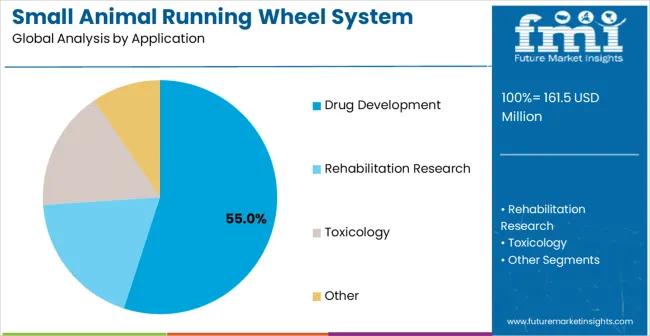
Drug development applications are expected to represent 55% of small animal running wheel system demand in 2025. This significant share reflects the massive pharmaceutical research market for preclinical drug testing and growing investment in automated research technologies for pharmaceutical development. Drug development applications enable comprehensive preclinical assessment through sophisticated behavioral monitoring, activity measurement, and treatment effect evaluation systems. The segment benefits from breakthrough advances in pharmaceutical research automation that makes sophisticated behavioral analysis accessible and critical for drug safety and efficacy evaluation.
The global pharmaceutical industry revolution drives significant demand for drug development animal research systems that provide exceptional behavioral monitoring capabilities and intelligent data collection for pharmaceutical research and regulatory compliance applications. These applications require animal research systems with superior data accuracy abilities and comprehensive research protocol integration to ensure reliable drug assessment and effective preclinical research capabilities. The segment benefits from growing pharmaceutical investment in preclinical research technologies and increasing adoption of standardized research methodologies and regulatory compliance solutions.
Pharmaceutical and biotechnology sectors contribute substantially to market growth as companies implement animal research systems in drug development programs and comprehensive preclinical research strategies. The growing adoption of automated research methodologies creates opportunities for specialized drug development animal research systems designed for pharmaceutical research applications and comprehensive regulatory compliance management.
The small animal running wheel system market is advancing steadily due to revolutionary pharmaceutical research development and unprecedented adoption of laboratory automation technologies across all research and pharmaceutical segments. However, the market faces challenges including high system costs, need for robust data validation protocols, and varying research requirements across different laboratory applications. Research ethics standards and animal welfare regulations continue to influence product development and market adoption patterns.
The revolutionary advances in data collection systems, behavioral analysis algorithms, and research automation technologies are enabling unprecedented research standardization while maintaining animal welfare and research ethics standards. Advanced data analytics architectures and research-specific monitoring systems provide superior behavioral measurement and data collection capabilities, enabling dynamic research optimization and enhanced research reproducibility. These technologies are particularly valuable for pharmaceutical applications that require sophisticated behavioral analysis, accurate data collection, and reliable research standardization protocols.
Modern small animal running wheel system manufacturers are implementing breakthrough ecosystem integration and comprehensive research platform development that enables seamless laboratory integration while supporting holistic research optimization and data management enhancement. Advanced platform architectures enable unified research monitoring, data collection, and research management while ensuring animal welfare compliance and research ethics requirements.
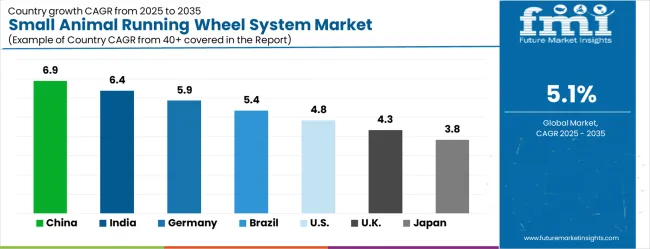
| Country | CAGR (2025-2035) |
|---|---|
| China | 6.9% |
| India | 6.4% |
| Germany | 5.9% |
| Brazil | 5.4% |
| United States | 4.8% |
| United Kingdom | 4.3% |
| Japan | 3.8% |
The small animal running wheel system market is experiencing moderate growth, with China leading at 6.9% CAGR through 2035, driven by massive pharmaceutical research investment and rapidly expanding biotechnology research infrastructure. India follows at 6.4%, supported by enormous pharmaceutical manufacturing potential and increasing research and development investment. Germany records strong growth at 5.9%, emphasizing pharmaceutical innovation excellence and advanced research technology development. Brazil grows steadily at 5.4%, benefiting from expanding pharmaceutical research and biotechnology development. The United States shows solid growth at 4.8%, focusing on pharmaceutical research leadership and advanced laboratory applications. The United Kingdom maintains steady expansion at 4.3%, supported by pharmaceutical research advancement. Japan demonstrates consistent growth at 3.8%, emphasizing precision research technology and pharmaceutical excellence.
The report covers an in-depth analysis of 40+ countries top-performing countries are highlighted below.
Revenue from small animal running wheel systems in China is projected to exhibit the highest growth rate with a CAGR of 6.9% through 2035, driven by the country's position as a global pharmaceutical manufacturing powerhouse and massive domestic investment in biotechnology research infrastructure. The extensive pharmaceutical research capabilities and unprecedented investment in laboratory automation technology are creating extraordinary opportunities for animal research system adoption. Major pharmaceutical and biotechnology companies are developing world-leading research capabilities to serve both the enormous domestic pharmaceutical market and global research expansion while establishing leadership in preclinical research applications.
Revenue from small animal running wheel systems in India is expanding at a CAGR of 6.4%, supported by the country's massive pharmaceutical manufacturing potential and rapidly accelerating research and development across all pharmaceutical segments and biotechnology operations. The enormous pharmaceutical manufacturing growth and increasing research investment are driving extraordinary animal research system demand potential. Research technology companies are leveraging India's vast pharmaceutical market while developing cost-effective research solutions to capture emerging opportunities in pharmaceutical research and preclinical development applications.
Demand for small animal running wheel systems in Germany is projected to grow at a CAGR of 5.9%, supported by the country's leadership in pharmaceutical innovation and advanced research technology development across pharmaceutical, chemical, and biotechnology sectors. German research technology companies are implementing sophisticated animal research development that meets stringent regulatory standards and research requirements while delivering superior research properties and system reliability. The market is characterized by focus on pharmaceutical innovation, advanced technology integration, and compliance with comprehensive research ethics and animal welfare regulations.
Revenue from small animal running wheel systems in Brazil is growing at a CAGR of 5.4%, driven by expanding pharmaceutical research development and increasing biotechnology investment across urban and emerging pharmaceutical market segments. The growing pharmaceutical research awareness and increasing research infrastructure development are creating substantial opportunities for animal research system market development. Research technology companies are adapting animal research systems to support growing pharmaceutical demand and research development while maintaining cost accessibility and local market relevance.
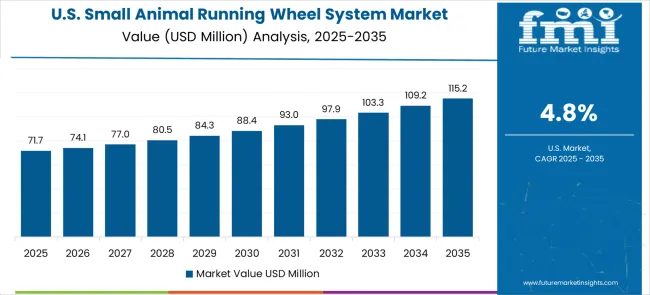
Demand for small animal running wheel systems in the United States is expanding at a CAGR of 4.8%, driven by the country's pharmaceutical research leadership and research market demand for advanced animal research products and cutting-edge laboratory technologies. The sophisticated pharmaceutical infrastructure and research willingness to invest in advanced animal research systems create enormous demand for high-performance pharmaceutical research solutions. The market benefits from breakthrough research technology development and pharmaceutical-grade research market segments across pharmaceutical, biotechnology, and academic applications.
Demand for small animal running wheel systems in the United Kingdom is projected to grow at a CAGR of 4.3%, supported by ongoing pharmaceutical innovation advancement and increasing research demand for intelligent animal research products in pharmaceutical and academic research applications. Research technology companies are investing in pharmaceutical research development that provides advanced functionality while meeting research ethics requirements and regulatory compliance for pharmaceutical applications. The market is characterized by focus on pharmaceutical innovation, research ethics protection, and advanced technology integration across diverse pharmaceutical research segments.
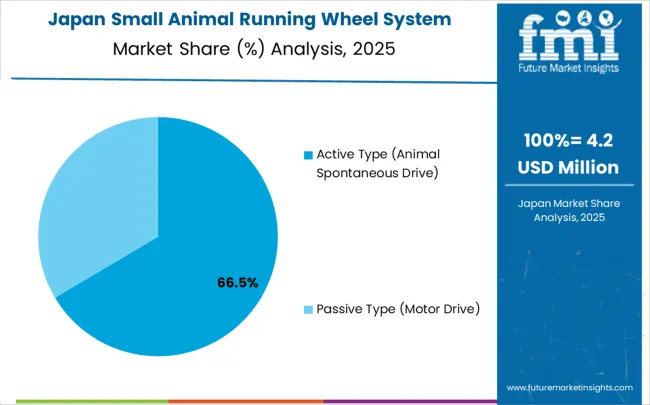
Demand for small animal running wheel systems in Japan is expanding at a CAGR of 3.8%, driven by the country's emphasis on research technology excellence and precision pharmaceutical development across pharmaceutical, electronics, and biotechnology sectors. Japanese research technology companies are developing sophisticated animal research applications that incorporate precision engineering and pharmaceutical optimization principles. The market benefits from focus on research precision, technology reliability, and continuous innovation in pharmaceutical research technology and laboratory research integration.
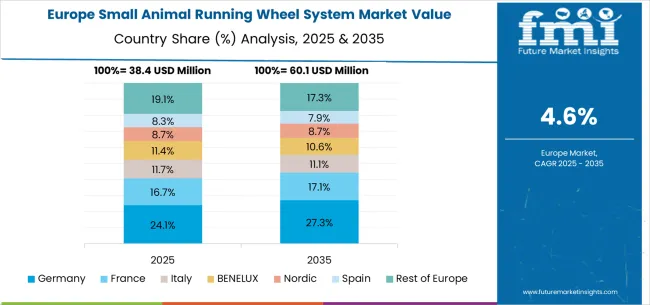
The small animal running wheel system market in Europe is projected to grow from USD 43.2 million in 2025 to USD 71.1 million by 2035, registering a CAGR of 5.1% over the forecast period. Germany is expected to maintain its leadership with a 32.8% share in 2025, supported by its advanced pharmaceutical research industry and laboratory technology excellence. The United Kingdom follows with 23.6% market share, driven by pharmaceutical innovation advancement and research technology development. France holds 19.4% of the European market, benefiting from pharmaceutical research expansion and laboratory equipment industry development. Italy and Spain collectively represent 15.2% of regional demand, with growing focus on pharmaceutical research development and laboratory technology applications. The Rest of Europe region accounts for 9.0% of the market, supported by research technology development in Eastern European countries and Nordic pharmaceutical innovation advancement.
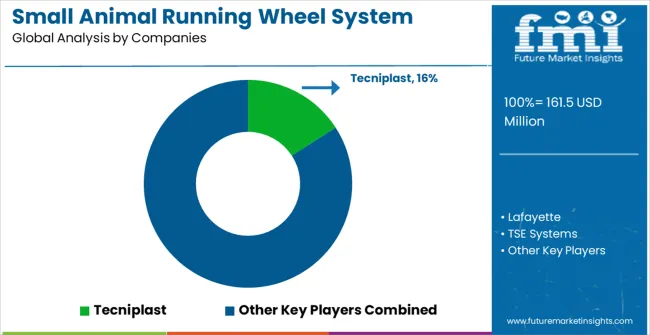
The small animal running wheel system market is defined by moderate competition among specialized laboratory equipment manufacturers, innovative research automation companies, and established pharmaceutical research suppliers. Companies are investing in research automation development, advanced product design, research data validation, and laboratory ecosystem integration to deliver reliable, ethical, and research-compatible animal research products. Strategic partnerships, technological advancement, and steady pharmaceutical market expansion are central to achieving market leadership and research adoption.
Tecniplast, operating globally, offers comprehensive animal research solutions with focus on laboratory and pharmaceutical applications, research performance optimization, and seamless laboratory integration across research equipment, monitoring systems, and laboratory services applications. Lafayette, technology provider, delivers advanced research systems with emphasis on laboratory reliability, research performance, and intelligent research monitoring capabilities. TSE Systems provides innovative research automation with focus on comprehensive laboratory integration and high-performance research applications. Med Associates offers precision research systems with advanced behavioral monitoring and laboratory-grade performance capabilities.
STARR Life Sciences provides specialized research systems with emphasis on pharmaceutical and academic research applications. Jiangsu Saionsi Biotechnology delivers research automation with sophisticated research performance and laboratory optimization capabilities. Anhui Yaokun Biotechnology offers comprehensive research solutions with research monitoring integration and laboratory research services. Beijing Zhishu Duobao Biotechnology provides research systems with advanced laboratory integration and pharmaceutical research systems.
Shanghai Tawang Intelligent Technology, Anhui Zhenghua Biological Instruments and Equipment, Shanghai Ruanlong Technology Development, Beijing Laite Technology Development, Zhongke Zhongjia (Beijing) Technology, and Nanjing Calvin Biotechnology offer specialized research automation expertise, innovative product development, and technical advancement across laboratory equipment and pharmaceutical research networks.
The small animal running wheel system market underpins pharmaceutical research revolution, preclinical research advancement, laboratory automation democratization, and pharmaceutical research optimization evolution. With accelerating pharmaceutical research, laboratory automation expansion, and research ethics requirements, the sector faces pressure to balance innovation velocity, animal welfare protection, and research data validation. Coordinated contributions from governments, industry bodies, OEMs/technology integrators, suppliers, and investors will accelerate the transition toward beneficial, ethical, and universally accessible small animal research system ecosystems.
| Item | Value |
|---|---|
| Quantitative Units | USD 161.5 million |
| System Type | Active Type (Animal Spontaneous Drive), Passive Type (Motor Drive), Others |
| Application | Drug Development, Rehabilitation Research, Toxicology, Others |
| Regions Covered | North America, Europe, East Asia, South Asia & Pacific, Latin America, Middle East & Africa |
| Country Covered | United States, Germany, India, China, United Kingdom, Japan, Brazil, and other 40+ countries |
| Key Companies Profiled | Tecniplast, Lafayette, TSE Systems, Med Associates, STARR Life Sciences, Jiangsu Saionsi Biotechnology, Anhui Yaokun Biotechnology, Beijing Zhishu Duobao Biotechnology, Shanghai Tawang Intelligent Technology, Anhui Zhenghua Biological Instruments and Equipment, Shanghai Ruanlong Technology Development, Beijing Laite Technology Development, Zhongke Zhongjia (Beijing) Technology, Nanjing Calvin Biotechnology |
The global small animal running wheel system market is estimated to be valued at USD 161.5 million in 2025.
The market size for the small animal running wheel system market is projected to reach USD 265.6 million by 2035.
The small animal running wheel system market is expected to grow at a 5.1% CAGR between 2025 and 2035.
The key product types in small animal running wheel system market are active type (animal spontaneous drive) and passive type (motor drive).
In terms of application, drug development segment to command 55.0% share in the small animal running wheel system market in 2025.






Our Research Products

The "Full Research Suite" delivers actionable market intel, deep dives on markets or technologies, so clients act faster, cut risk, and unlock growth.

The Leaderboard benchmarks and ranks top vendors, classifying them as Established Leaders, Leading Challengers, or Disruptors & Challengers.

Locates where complements amplify value and substitutes erode it, forecasting net impact by horizon

We deliver granular, decision-grade intel: market sizing, 5-year forecasts, pricing, adoption, usage, revenue, and operational KPIs—plus competitor tracking, regulation, and value chains—across 60 countries broadly.

Spot the shifts before they hit your P&L. We track inflection points, adoption curves, pricing moves, and ecosystem plays to show where demand is heading, why it is changing, and what to do next across high-growth markets and disruptive tech

Real-time reads of user behavior. We track shifting priorities, perceptions of today’s and next-gen services, and provider experience, then pace how fast tech moves from trial to adoption, blending buyer, consumer, and channel inputs with social signals (#WhySwitch, #UX).

Partner with our analyst team to build a custom report designed around your business priorities. From analysing market trends to assessing competitors or crafting bespoke datasets, we tailor insights to your needs.
Supplier Intelligence
Discovery & Profiling
Capacity & Footprint
Performance & Risk
Compliance & Governance
Commercial Readiness
Who Supplies Whom
Scorecards & Shortlists
Playbooks & Docs
Category Intelligence
Definition & Scope
Demand & Use Cases
Cost Drivers
Market Structure
Supply Chain Map
Trade & Policy
Operating Norms
Deliverables
Buyer Intelligence
Account Basics
Spend & Scope
Procurement Model
Vendor Requirements
Terms & Policies
Entry Strategy
Pain Points & Triggers
Outputs
Pricing Analysis
Benchmarks
Trends
Should-Cost
Indexation
Landed Cost
Commercial Terms
Deliverables
Brand Analysis
Positioning & Value Prop
Share & Presence
Customer Evidence
Go-to-Market
Digital & Reputation
Compliance & Trust
KPIs & Gaps
Outputs
Full Research Suite comprises of:
Market outlook & trends analysis
Interviews & case studies
Strategic recommendations
Vendor profiles & capabilities analysis
5-year forecasts
8 regions and 60+ country-level data splits
Market segment data splits
12 months of continuous data updates
DELIVERED AS:
PDF EXCEL ONLINE
Small Molecule Brominated Flame Retardants Market Size and Share Forecast Outlook 2025 to 2035
Small Form Factor (SFF) Connectors Market Size and Share Forecast Outlook 2025 to 2035
Small Satellite Market Size and Share Forecast Outlook 2025 to 2035
Small Marine Engine Market Forecast Outlook 2025 to 2035
Small Gas Engine Market Size and Share Forecast Outlook 2025 to 2035
Small Molecule CDMO Market Size and Share Forecast Outlook 2025 to 2035
Small Molecule CMO/CDMO Market Size and Share Forecast Outlook 2025 to 2035
Small Molecule-Drug Conjugates Market Size and Share Forecast Outlook 2025 to 2035
Small Caliber Ammunition Market Size and Share Forecast Outlook 2025 to 2035
Small Boats Market Size and Share Forecast Outlook 2025 to 2035
Small Capacity Electrolyzer Market Size and Share Forecast Outlook 2025 to 2035
Small Cell Lung Cancer (SCLC) Treatment Market Size and Share Forecast Outlook 2025 to 2035
Small Molecule Innovator CDMO Market Size and Share Forecast Outlook 2025 to 2035
Small Cell Network Market Size and Share Forecast Outlook 2025 to 2035
Small Wind Turbine Market Size and Share Forecast Outlook 2025 to 2035
Small Off-Road Engines Market Size and Share Forecast Outlook 2025 to 2035
Small Continuous Fryer Market Size and Share Forecast Outlook 2025 to 2035
Small Molecule Inhibitors Market Analysis – Size, Share, and Forecast Outlook 2025 to 2035
Small Signal Transistor Market Size and Share Forecast Outlook 2025 to 2035
Small Bowel Enteroscopes Market Size and Share Forecast Outlook 2025 to 2035

Thank you!
You will receive an email from our Business Development Manager. Please be sure to check your SPAM/JUNK folder too.
Chat With
MaRIA